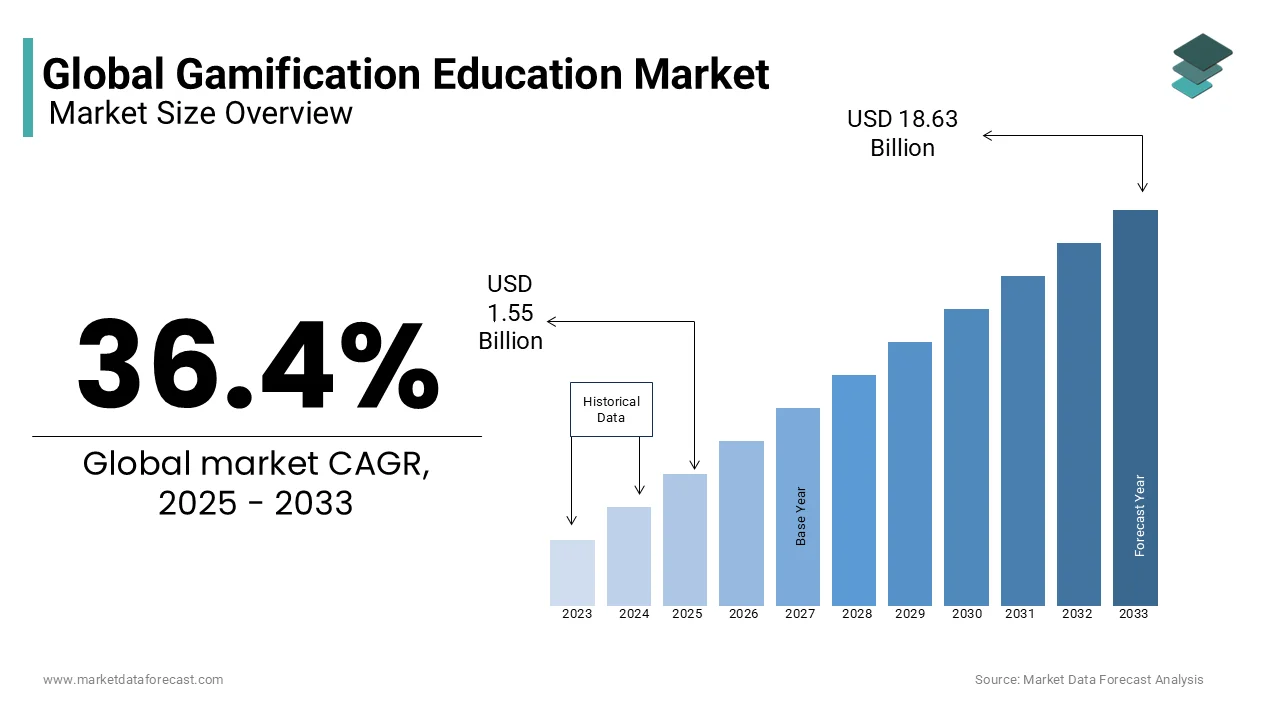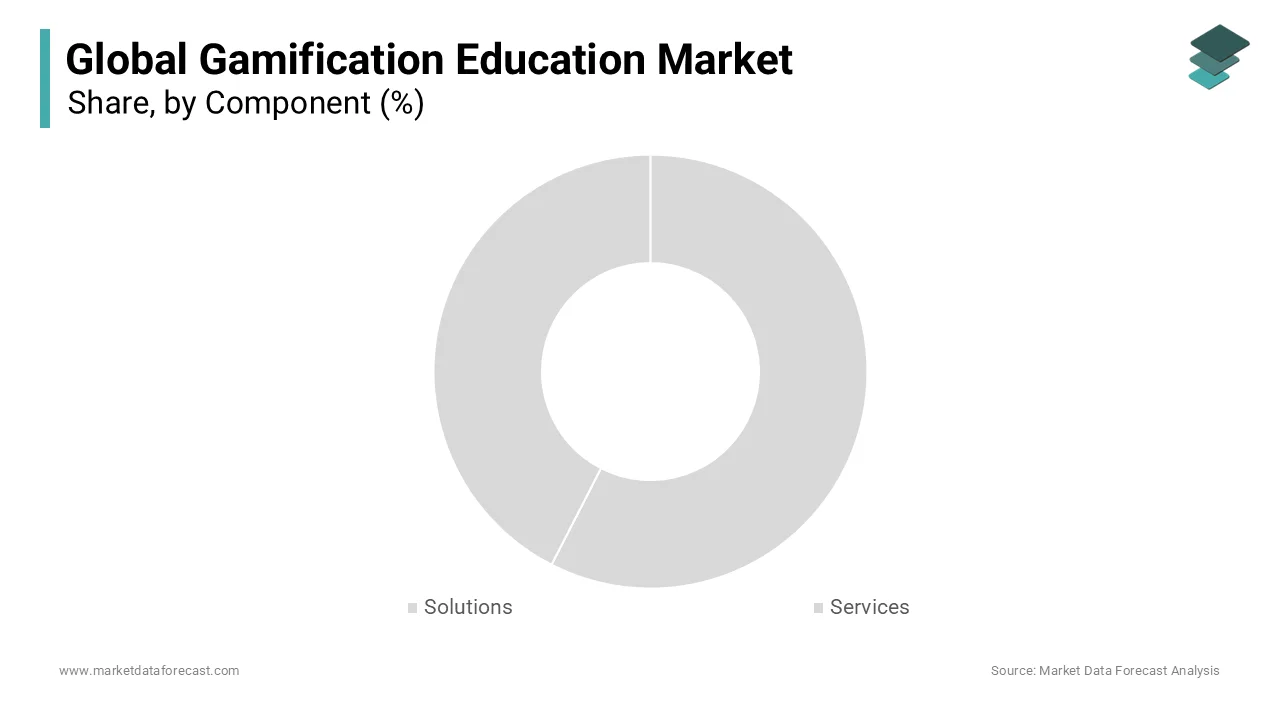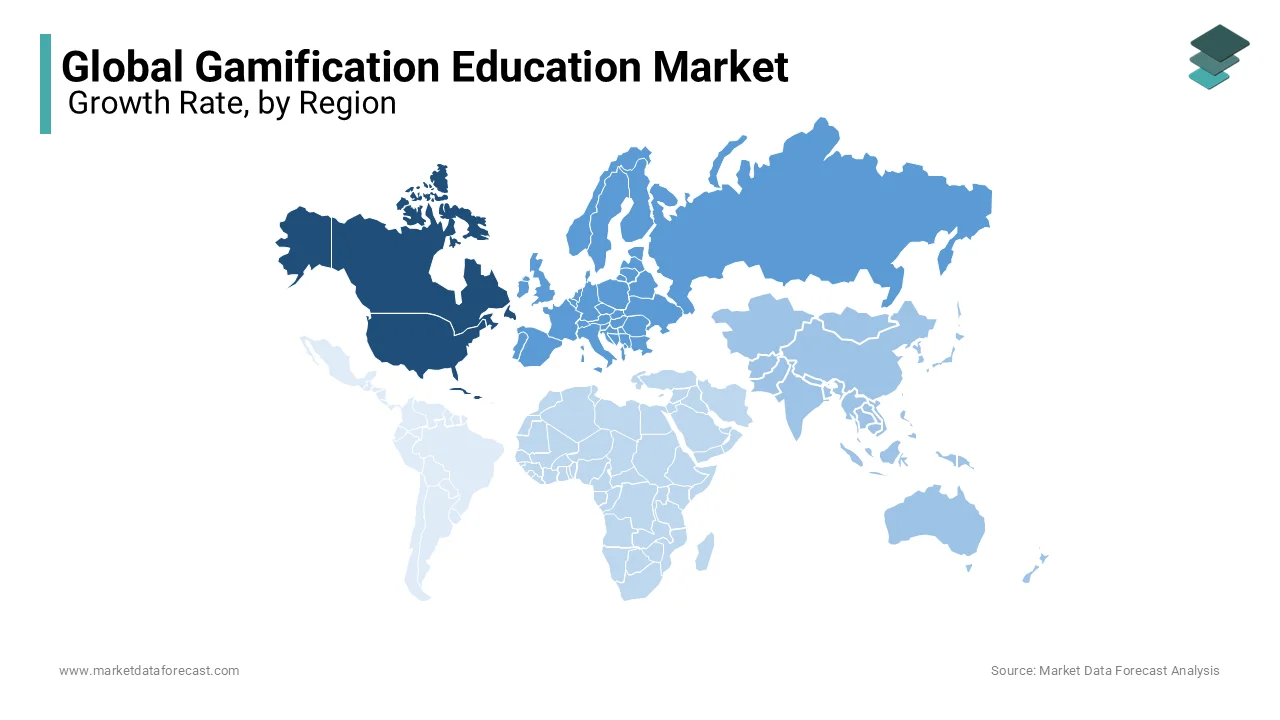Global Gamification Education Market Size, Share, Trends, & Growth Forecast Report By Component (Solutions and Services), End-user (Academic and Corporate Training), Deployment Mode (Cloud and On-premise), and Region (North America, Europe, Asia Pacific, Latin America, and Middle East & Africa), Industry Analysis From 2024 to 2033
Global Gamification Education Market Size
The global gamification education market was worth USD 1.14 billion in 2024. The global market is predicted to grow from USD 1.55 billion in 2025 to USD 18.63 billion by 2033, growing at a CAGR of 36.4% during the forecast period.

Gamification in education refers to the integration of gaming elements, mechanics, and principles into the learning process to enhance engagement, motivation, and learning outcomes. It involves using elements commonly found in games, such as points, badges, leaderboards, challenges, quests, and rewards, within educational contexts. By applying these game-like features, educators aim to make learning more interactive, enjoyable, and immersive, encouraging students to actively participate and progress in their studies. Gamification in education leverages the inherent appeal of games to stimulate students' interest, boost motivation, promote collaboration, and improve retention and understanding of educational content.
The gamification education market has attained astonishing prominence in recent years. With customer retention and engagement levels decreasing due to COVID-19 and people's attention period following a downward trend, gamification is presenting as a timely cure or remedy to these incidences. However, presently, reproducing game mechanics in commercial circumstances is a tough one to crack, particularly with the sprouting market trends. Moreover, the market is experiencing the rising popularity of virtual reality-based learning. It is one of the rapidly expanding categories in 2024 so far.
- Challenge-based gamification enhanced the performance of students by around 89.45 per cent in contrast to lecture-based education, as per Science Direct.
MARKET DRIVERS
Integration of Digital Devices in Educational Settings
The growth of the global gamification education market is primarily driven by the widespread integration of digital devices in educational settings. The surge in mobile apps, online platforms, and educational software has empowered educators to seamlessly incorporate gamified elements into their teaching methodologies. This technological integration not only enhances engagement but also provides a dynamic and interactive learning environment. Students, being digital natives, readily embrace gamification, fostering a more immersive educational experience. The adaptability of gamification to various digital formats ensures accessibility and scalability, catering to diverse learning preferences. As education continues to embrace technological advancements, the gamification education market thrives on the synergy between innovative digital tools and pedagogical strategies, promising a future where learning is informative, inherently engaging, and enjoyable.
- According to the study by the Universidad Nacional De Colombia and the University of Alicante, experiments including the game-based teaching platform Kahoot discovered that 88 per cent of learners participated in the study “have fun and learn” when engaged in Kahoot, offering a positive sign of motivation. When questioned about the role of gaming platforms in improving their classroom knowledge over 54 per cent affirmed that the teaching method was beneficial to them.
In the dynamic landscape of the gamification education market, a key driver is the profound impact on student engagement and motivation. Through the strategic infusion of game-like elements such as points, badges, and leaderboards, educators are witnessing a transformative shift in classroom dynamics. Gamification breathes life into learning activities, cultivating a sense of excitement and involvement among students. The allure of earning points, achieving badges, and competing on leaderboards instills a competitive spirit that motivates active participation. This fosters a positive learning environment and nurtures a sense of accomplishment, driving students to excel. As the market evolves, the potent combination of gamification and education continues to redefine how students interact with academic content, promising sustained enthusiasm and heightened educational outcomes in an increasingly gamified educational landscape.
MARKET RESTRAINTS
Implementation Challenges
The gamification education market encounters a significant restraint in the form of implementation challenges that educators grapple with. Integrating gamification into the curriculum demands a paradigm shift, necessitating extensive training for educators to utilize game-like elements effectively. The time-intensive nature of this training, coupled with educators' already constrained schedules, creates an obstacle to seamless integration. Moreover, resistance to change within educational institutions poses a formidable barrier, as some educators may be hesitant to depart from traditional teaching methods. As the market evolves, solutions addressing these implementation challenges will be pivotal in ensuring the successful adoption of gamification in education, unlocking its full potential to enhance student engagement and learning outcomes.
Ethical considerations emerge as a critical factor influencing adoption within the gamification education market. The integration of competition and rewards raises concerns about potential inequities, as some students may thrive in competitive environments while others may feel undue pressure. Striking a balance between healthy competition and individualized learning requires careful navigation.
Additionally, the collection of student data for gamification purposes demands robust privacy regulations to safeguard sensitive information. Ensuring transparent data practices and obtaining informed consent become imperative in the ethical deployment of gamified education. The market's sustained growth hinges on industry stakeholders proactively addressing these ethical concerns through responsible design, comprehensive guidelines, and collaboration with regulatory bodies, fostering an environment where gamification not only enhances learning outcomes but also upholds the ethical standards essential for the well-being of students.
MARKET OPPORTUNITIES
Personalised Learning Experience
Personalised learning experience presents potential opportunities for the expansion of the gamification education market. This notion makes individualised educational prospects possible. Learners have the facility to advance or move forward at their own pace by taking activities which are suitable for their age group and experience level. Education 5.0 also emphasizes personalized and student-oriented education using digital technologies. It improves involvement, enhances learning outcomes, and widens access to education. The main characteristics include interactive tools, such as VR and gamification, and customised learning and higher availability through digital platforms. It places a strong focus on emotional and social development.
Additionally, Asia Pacific is an attractive market as it is the fastest-growing region with a huge customer base. Moreover, 2 out of the 3 biggest online gaming audiences are present in APAC which are China and Japan. So, the demand for challenge-based gamification is expected to escalate in the next few years.
- A study by the Academy of Animate Dart, there are about 3.2 billion video gamers globally, and online players are around 1.17 billion. Till 2024, China was the biggest market, i.e. 742.19 million players, for online gaming in terms of revenue. In addition, the maximum penetration rate of online gaming is in the Philippines with 96.4 per cent of internet consumers for all devices.
MARKET CHALLENGES
Failure to Incorporate Gamification into the Syllabus
The adoption of digital technologies is increasing year-on-year (YoY) basis, so the screen time of kids and students is bound to climb, which ultimately affects their eyesight.
- According to the Time of India, about 20 per cent of children suffering from moderate to serious dry eye disease were due to higher screen time with a decrease in blinking rate.
Failure to incorporate gamification into the syllabus or program is another factor hindering the expansion of the market. There is no single design or framework that fits every e-learning concept. The design should be personalised as per the requirements and aptness of all the learners. Hence, the inability to merge this into the curriculum is a major challenge for the market.
REPORT COVERAGE
|
REPORT METRIC |
DETAILS |
|
Market Size Available |
2024 to 2033 |
|
Base Year |
2024 |
|
Forecast Period |
2025 to 2033 |
|
CAGR |
36.4% |
|
Segments Covered |
By Component, Delivery Mode, End-User, and Region |
|
Various Analyses Covered |
Global, Regional & Country Level Analysis, Segment-Level Analysis, DROC, PESTLE Analysis, Porter’s Five Forces Analysis, Competitive Landscape, Analyst Overview of Investment Opportunities |
|
Regions Covered |
North America, Europe, APAC, Latin America, Middle East & Africa |
|
Market Leaders Profiled |
Kahoot, Classcraft, Duolingo, Prodigy, Socrative, Minecraft Education Edition, Quizziz, Education Perfect, GooseChase, Nearpod, and others. |
SEGMENTAL ANALYSIS
By Component Insights
The gamification solutions sector leads the education market, offering diverse software and platforms that infuse game-based elements into learning. Encompassing learning management systems, educational games, mobile apps, and interactive platforms, they cater to various subjects and age groups. These solutions integrate features like progress tracking, rewards, quizzes, simulations, and immersive experiences, engaging students and aiding knowledge retention. Under the sub-segments, Cloud-based solutions have gained traction in the gamification education sector. These solutions offer scalable infrastructure, facilitating access to gamified learning platforms, interactive content, and collaboration tools. Cloud computing enables seamless deployment and accessibility across devices, allowing educators to deliver immersive learning experiences without significant hardware investments.

The service sector will hold a significant market share during the forecast period as educational institutions embrace gamification. They require guidance and support to implement these solutions effectively. Service providers offering consultation, customization, and ongoing support will gain prominence, especially as institutions seek to align gamification strategies with their specific curriculum, pedagogy, and student requirements.
By End-User Insights
The academic segment dominates the gamification education market, spanning K-12 schools to higher education institutions. It embraces gamification to elevate student engagement and learning outcomes and aims to transform education into an interactive experience. Institutions seek gamification tools aligned with varied subjects and curricula, integrating game-based elements to enhance traditional learning methods. By leveraging gamification, educators aim to boost student motivation, knowledge retention, and academic performance, fostering a more engaging and effective learning environment across diverse age groups and subjects.
Corporate Training holds the second largest market share during the forecast period; it is swiftly adopting gamification, acknowledging its effectiveness in creating engaging learning environments for employees. Businesses prioritize this approach to keep their workforce engaged and equipped with evolving skills. Increased investment in gamified corporate training solutions reflects the recognition of gamification's impact in modernizing employee learning, ensuring their continual development in line with dynamic industry demands.
By Deployment Mode insights
On-premise solutions lead the market as educational institutions prioritize retaining control over their data and infrastructure. Initially preferred for its customization and data security benefits, on-premise deployments gained traction. Institutions value the ability to customize solutions to specific needs and uphold stringent data security measures. This dominance reflects the preference for maintaining control over resources and data within educational settings, aligning with their requirements for tailored and secure technology deployments.
Cloud-based gamification solutions are expected to showcase a healthy CAGR during the forecast period. They offer educational institutions and users flexibility, scalability, and accessibility. Hosted on remote servers, they ensure easy internet access, seamless updates, and reduced infrastructure costs. Ideal for hassle-free implementation and maintenance, these platforms scale resources as needed, efficiently managing student loads. Additionally, collaborative features foster inclusivity, enabling access to learning materials from anywhere and nurturing a collaborative learning environment.
REGIONAL ANALYSIS
North America is dominating the Gamification Education Market with 40% of the global market share, due to its advanced technological landscape and a strong emphasis on innovative learning methodologies. The United States and Canada boast extensive investments in ed-tech startups, fostering gamified learning platforms. Institutions here leverage gamification to enhance student engagement, driving the market's dominance.
- According to eLearning Learning, about 80 per cent of the United States workers found game-based learning a more interactive approach to learning, while the launch of this technique was also determined to have a beneficial effect as reported by organisations who identified utilising games or challenges within their educational approach to surge employee involvement by 60 per cent and efficiency by 50 per cent.

Europe holds a second-leading market share, particularly in countries like the UK, Germany, and Scandinavia, which are known for their progressive education systems. These nations actively integrate gamified approaches into curricula, emphasising interactive learning experiences. The region's commitment to educational reforms contributes to its substantial market share.
- As per research by the European CEO, about 50 per cent of business transformation initiatives fail to achieve success due to poor engagement of employees.
The Asia-Pacific region is rapidly embracing gamification in education market with 37% CAGR in 2024. Countries like China, India, and South Korea are witnessing a surge in adoption, leveraging gamified learning apps and platforms. Governments here are increasingly promoting tech-driven education initiatives, influencing market growth.
The Middle East and Africa are gradually exploring gamified educational tools. Though the market share is smaller, countries like the UAE and South Africa are introducing gamification to augment traditional teaching methods, fostering engagement among students.
Latin America is progressively integrating gamification into education, albeit at a slower pace compared to other regions. Nations like Brazil and Mexico are witnessing a gradual adoption of gamified learning platforms to enhance student motivation and participation.
KEY MARKET PLAYERS
Companies playing a notable role in the global gamification education market include Kahoot, Classcraft, Duolingo, Prodigy, Socrative, Minecraft Education Edition, Quizziz, Education Perfect, GooseChase, Nearpod, and others.
RECENT HAPPENINGS IN THE MARKET
- In August 2024, Trust Wallet introduced Trust Wallet Quests which is a platform for gamified education under the Trust Wallet mobile app. It propels customers to earn points at the time educating and exploring regarding Web3.
MARKET SEGMENTATION
This research report on the global gamification education market has been segmented and sub-segmented based on component, delivery mode, end-user, and region.
By Component
- Solutions
- Cloud computing
- Big data
- Analytics
- Mobility
- Disruptive technologies
- Social media
- Services
By End-User
- Academic
- K12
- Higher education
- Corporate Training
- SMEs
- Large enterprises
By Deployment Mode
- Cloud
- On-premises
By Region
- North America
- Europe
- Asia-Pacific
- Latin America
- Middle East and Africa
Frequently Asked Questions
What is the current size of the global gamification education market?
The global gamification education market size is expected to be valued at USD 1.55 billion in 2025.
Which regions contribute the most to the global gamification education market share?
North America, Europe, and Asia-Pacific are among the leading contributors to the global gamification education market share, with a growing adoption of gamified learning solutions in schools and institutions.
What factors are driving the growth of the gamification education market globally?
The growth of the gamification education market is driven by factors such as increased engagement among students, the effectiveness of gamified learning in improving retention, and advancements in educational technology.
How has the COVID-19 pandemic affected the global gamification education market?
The COVID-19 pandemic has accelerated the adoption of gamification in education, with remote and hybrid learning environments driving the need for engaging and interactive online educational experiences.
Related Reports
Access the study in MULTIPLE FORMATS
Purchase options starting from $ 2500
Didn’t find what you’re looking for?
TALK TO OUR ANALYST TEAM
Need something within your budget?
NO WORRIES! WE GOT YOU COVERED!
Call us on: +1 888 702 9696 (U.S Toll Free)
Write to us: [email protected]